Moira Butterfield's Blog, page 10
August 21, 2022
Surviving difficult projects - advice by Moira Butterfield
Film adaptions are famously long-winded and difficult. There’s even a phrase for it – development hell. According to Douglas Adams:
“The Hollywood Process is like trying to grill a steak by having a succession of people coming into the room and breathing on it.”
For writers it’s notoriously soul-destroying. The processes in children’s book publishing aren’t that bad, thank goodness, but it may not all be plain-sailing from contract-signing to publication and it can be difficult to maintain enthusiasm for a writing project when it goes through difficult times. After the initial joy of having a book accepted, there may be many rocks to navigate and perhaps some becalming, too.
Examples of reversals a writer might encounter
* An editor wanting you to rewrite parts of your content, perhaps even more that once.
* An editor leaving and your project going into temporary limbo.
* New staff arriving and wanting to shift the focus of the project.
* Changes from an international publisher wanting to buy rights, but only if you play ball.
* Delays while an artist is found.
* Delays you just don’t grasp due to lack of communication.
I am giving you a list of worse scenarios here to show you that all these things can occur to all writers at some point, and if they happen to you – well, you are not alone. Many of your fellow writers will recognise the situations and sympathise.
My suggestions
Redevelopment – Get it clear in your mind what the editor is saying they want. If it’s not clear then ask them to make it clearer. Discussing it with them face-to-face will greatly help here.
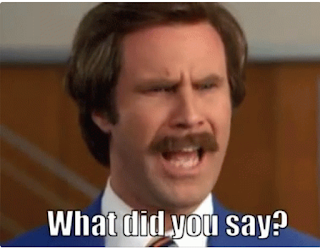
Be flexible and open-minded. Think around the suggestions being made. Are they a good idea? Is there another solution you think might work better and that you could both think about? Be as positive as is possible. You’re working together to make the work great.
A good thing here is to rewrite your brief for yourself. What was your initial idea? What were its strengths. What were you writing it for? Reconfirm these things to yourself to reinforce your confidence in your decision.
Keep all emails so you have a development trail of what’s been asked of you. If things change a great deal over and over again (Yes – actual development hell occurs) you are perfectly justified, and it’s professionally acceptable, to ask for more money.
If it comes to the point where you think ‘no this is not what I want’, then say so calmly and logically along with your reasons. Your editor might agree with your points after thinking about it. If not, then it’s time to move the project to someone else. That is a positive thing to do for your project. It’s not your failure. Shut the door on development hell.
There’s not much to be done about delays but don’t be hesitant to communicate with your editor and ask them what’s going on.

Difficult projects can really take a toll so take care of your mental health. That means remembering that you are creative, for example, by taking time out to play and by working on other things.
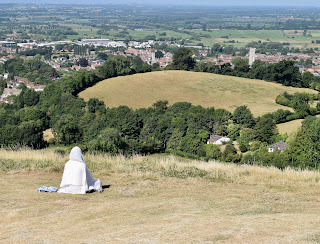 Do what you need to do to look after your head. (pic: my friend John Miles
Do what you need to do to look after your head. (pic: my friend John Miles found someone meditating on the top of Glastonbury Tor last week)
Also please, please remember that you are not alone and even the most famous writers have setbacks. Reach out to your friends in the writing community. They will understand your feelings better than anyone.
Writing is hard and sometimes the process of publishing makes it harder. That’s the simple truth of it. Be ready but be positive, be open-minded and be true to what you are aiming for.
Moira Butterfield is an internationally-published author whose Nosy Crow book Welcome To Our World has just been translated into its 15th language. Her newest book – Sometimes I’m a Baby Bear, Sometimes I’m a Snail (|Welbeck) aims to give young children tools to express their feelings.
Moira Butterfield
moira@moiraworld.co.uk
www.moirabutterfield.co.uk
twitter @moiraworld
instagram @moirabutterfieldauthor
August 14, 2022
35 WEBSITES FOR PICTURE BOOKS CREATORS!
I am constantly finding new and useful picture book resources online, as well as websites that help me navigate life as a children’s writer. Sometimes it’s hard to keep of track of the plethora of advice, tips and book recommendations, many of which are free.
So, today’s Picture Book Den post comes to you from a picture book lover and children’s author looking for one place to keep the resources she likes and uses the most.
Without further ado, in no particular order…
1. STORY STORM:
Previously PiBoIdMo, Storystorm has an incredible number of helpful posts featuring cover reveals, inspirations, author-illustrator processes and more! Each January, founder Tara Lazaar heads up a challenge that encourages picture book creators to come up with 30 new ideas in January. To get the creativity flowing, she invites published authors and illustrators to share prompts, exercises and posts each day of the month. I’ve yet to manage 30 new ideas but I always come away with a few new projects and the blog posts are there whenever you need a boost.
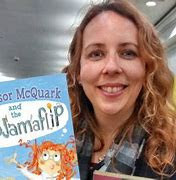 (Lou Treleaven)
(Lou Treleaven)
2. LOU TRELEAVEN:
Lou Treleaven is a talented writer of books for a range of ages. In addition to running courses and offering paid critiques, she has a list of agents and publishers on her website that are accepting submissions. A useful place for those looking to query their texts.
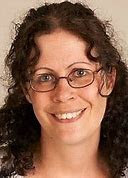 (Amy Sparkes)
(Amy Sparkes)
3. AMY SPARKES – STORY GODMOTHER:
AmySparkes is truly magical. Not only is she a fantastic author, scriptwriter (..and more, I can't keep up!), she also finds time to mentor aspiring writers and runs courses for those looking to learn more. If you don’t follow Amy on social media, you should! She regularly offers free critiques, courses, mentorships in return for donations to charity. If that wasn’t enough, Amy offers free writing tips every Wednesday on Twitter – just follow the hashtags #WednesdayWritingTips.
4. SOCIETY OF AUTHORS
If you’re ready to take your stories into schools, The Society of Authors has some useful advice for those looking to arrange visits, including how much to charge. If you have a contract that needs vetting, the Society of Authors also offers a free contract-checking service to its members. You can get liability insurance for an additional cost, too.
5 - 7. THE WORLD BOOK DAY SITE
Regarding visits and workshops, you can find useful advice on the World Book Day website. If you’re a step ahead and have already got an event booked, you could signpost people to this Book Trust article and this post from Sarah McIntyre with tips for getting the most from an author or illustrator visit.
8 - 10. RHYME ZONE
If I’m writing a rhyming text, I have Rhyme Zone permanently open. Other online rhyming dictionaries are available, but what I like about this one, is that you can easily search for synonyms and definitions in the event that your rhyme needs a rethink.
Rhymers might also like these resources from Catherine Emmett and Lyrical Language Lab helpful, especially if you’re unsure about meter and want to learn more about scansion.
11 - 22. BOOK BLOGGERS
Since we’re all picture book fans here, I’m assuming – like me – you love keeping abreast of new releases. I hear about most new titles on social media (mainly Instagram and Twitter) It would be worth following your favourite bloggers to stay up to date with what’s being published. It’ll help you get a sense of the market and publishers’ tastes, but also identify the strong hooks of the books that ‘make it.’
Some bloggers also have websites that host featured authors, illustrators and cover reveals. Here are a few to get you going:
BookBrunchand The Bookseller are other great places to stay on top of all the brilliant new titles being published and the latest big deals.
There are also teachers, librarian and lecturers sharing their passion for picture books. These sites are a must see:
 (Mathew Tobin)
(Mathew Tobin)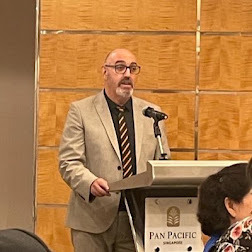 (Simon Smith)
(Simon Smith)
23 - 27. BOOKS FOR TOPICS
Another helpful thing to do when writing picture books is to scope out titles on a given subject to see what’s already been published and to make sure you are doing something different or something in a different way. Sites such as Books ForTopics do this brilliantly.
You could also look at Children’s Book Ireland, Little Parachutes, Booktrust, ReadingWell and who all group books by theme.
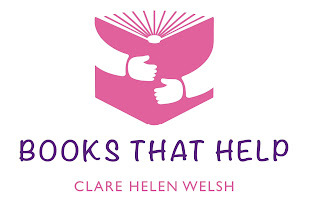 (Books That Help)
(Books That Help)
28. BOOKS THAT HELP
I hope it’s ok to shout out my new initiative, Books That Help. Books That Help is another place you can search for books on a particular topic, particularly those that help children navigate difficult times and big changes in their lives. There will be some opportunities for teachers and writers soon, too. Keep your eyes peeled for more!
 (Josh Funks)
(Josh Funks)
29. JOSH FUNKS
If you’re looking to perfect the writing of picture books, there are some free ‘lessons’ from US author Josh Funks, covering everything from 'word counts' to 'story arcs' to 'showing not telling.' All quick reads if you’re looking to brush up on the basics in your own time.
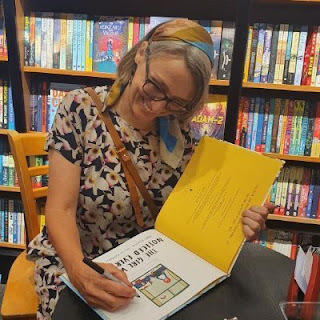 (Jane Porter)
(Jane Porter)
30. JANE PORTER
Author-illustrator Jane Porter has some fantastic videos on her YouTube channel looking at beautiful picture books. Some videos feature Jane talking through books she loves, but most are interviews with picture book creatives including Momoko Abe, Dapo Adeola, Rebecca Cobb, Diane Ewen and many more!
31. WRITE MENTOR
WriteMentor is a fantastic and affordable resource for writers, offering community, conferences, courses, mentorship and more. There are also some free resources available. Here are some links to blogs I write on picture books. There are more!
32. PICTURE BOOK BUILDERS
Picture book builders is a site run by a group of picture books creators who post articles on everything from what goes into a picture book, to how to hook a reader, to interviews with their favourite creatives and cover reveals.
33. NATASCHA BIEBOW
Natascha Biebow (OBE) is an industry editor, author and Regional Advisor for the Society of Children's Book Writers and Illustrators in the British Isles - she really knows her stuff! On her Story Shapers website there are six years' worth of free resources on picture book craft. Definitely well worth a look!
34. ARDEN JONES
Arden is a newly agented writer of rhyming picture books. She is starting a You Tube channel with live and pre-recorded rhyming picture book critiques - helpful videos about how to write in rhyme, how to understand meter and the do's and don'ts of rhyme.
Writers have the opportunity to get their work critiqued anonymously by submitting to picturebookswritinginrhyme@gmail.com. Do follow the submission guidelines. Sign up here!
35. PICTURE BOOK DEN
And last but not least, our very own Picture Book Den! A place for picture book fans to learn from writers and illustrators and to delve a little deeper in topics from accountability partners, plotting techniques, endpapers, illustration processes... there really is so much material to peruse. But of course, you knew about us already!
So there you have it!
A mega list of websites and resources for picture book creators.
I’ve almost certainly forgotten some – and no doubt there are many more I’ve yet to discover – so please do share your top websites too!
BIO:
Clare is children’s writer from Devon. She writes for a wide range of ages about a wide range of themes and has over 50 published titles. She founded the #BooksThatHelp initiative that aims to create honest emotional spaces for children through a love of reading and books.
34 WEBSITES FOR PICTURE BOOKS CREATORS!
I am constantly finding new and useful picture book resources online, as well as websites that help me navigate life as a children’s writer. Sometimes it’s hard to keep of track of the plethora of advice, tips and book recommendations, many of which are free.
So, today’s Picture Book Den post comes to you from a picture book lover and children’s author looking for one place to keep the resources she likes and uses the most.
Without further ado, in no particular order…
1. STORY STORM:
Previously PiBoIdMo, Storystorm has an incredible number of helpful posts featuring cover reveals, inspirations, author-illustrator processes and more! Each January, founder Tara Lazaar heads up a challenge that encourages picture book creators to come up with 30 new ideas in January. To get the creativity flowing, she invites published authors and illustrators to share prompts, exercises and posts each day of the month. I’ve yet to manage 30 new ideas but I always come away with a few new projects and the blog posts are there whenever you need a boost.
 (Lou Treleaven)
(Lou Treleaven)
2. LOU TRELEAVEN:
Lou Treleaven is a talented writer of books for a range of ages. In addition to running courses and offering paid critiques, she has a list of agents and publishers on her website that are accepting submissions. A useful place for those looking to query their texts.
 (Amy Sparkes)
(Amy Sparkes)
3. AMY SPARKES – STORY GODMOTHER:
AmySparkes is truly magical. Not only is she a fantastic author, scriptwriter (..and more, I can't keep up!), she also finds time to mentor aspiring writers and runs courses for those looking to learn more. If you don’t follow Amy on social media, you should! She regularly offers free critiques, courses, mentorships in return for donations to charity. If that wasn’t enough, Amy offers free writing tips every Wednesday on Twitter – just follow the hashtags #WednesdayWritingTips.
4. SOCIETY OF AUTHORS
If you’re ready to take your stories into schools, The Society of Authors has some useful advice for those looking to arrange visits, including how much to charge. If you have a contract that needs vetting, the Society of Authors also offers a free contract-checking service to its members. You can get liability insurance for an additional cost, too.
5 - 7. THE WORLD BOOK DAY SITE
Regarding visits and workshops, you can find useful advice on the World Book Day website. If you’re a step ahead and have already got an event booked, you could signpost people to this Book Trust article and this post from Sarah McIntyre with tips for getting the most from an author or illustrator visit.
8 - 10. RHYME ZONE
If I’m writing a rhyming text, I have Rhyme Zone permanently open. Other online rhyming dictionaries are available, but what I like about this one, is that you can easily search for synonyms and definitions in the event that your rhyme needs a rethink.
Rhymers might also like these resources from Catherine Emmett and Lyrical Language Lab helpful, especially if you’re unsure about meter and want to learn more about scansion.
11 -21. BOOK BLOGGERS
Since we’re all picture book fans here, I’m assuming – like me – you love keeping abreast of new releases. I hear about most new titles on social media (mainly Instagram and Twitter) It would be worth following your favourite bloggers to stay up to date with what’s being published. It’ll help you get a sense of the market and publishers’ tastes, but also identify the strong hooks of the books that ‘make it.’
Some bloggers also have websites that host featured authors, illustrators and cover reveals. Here are a few to get you going:
BookBrunchand The Bookseller are other great places to stay on top of all the brilliant new titles being published and the latest big deals.
There are also teachers and lecturers sharing their passion for picture books. These sites are a must see:
 (Mathew Tobin)
(Mathew Tobin) (Simon Smith)
(Simon Smith)
22 - 26. BOOKS FOR TOPICS
Another helpful thing to do when writing picture books is to scope out titles on a given subject to see what’s already been published and to make sure you are doing something different or something in a different way. Sites such as Books ForTopics do this brilliantly.
You could also look at Children’s Book Ireland, Little Parachutes, Booktrust, ReadingWell and who all group books by theme.
 (Books That Help)
(Books That Help)
27. BOOKS THAT HELP
I hope it’s ok to shout out my new initiative, Books That Help. Books That Help is another place you can search for books on a particular topic, particularly those that help children navigate difficult times and big changes in their lives. There will be some opportunities for teachers and writers soon, too. Keep your eyes peeled for more!
 (Josh Funks)
(Josh Funks)
28. JOSH FUNKS
If you’re looking to perfect the writing of picture books, there are some free ‘lessons’ from US author Josh Funks, covering everything from 'word counts' to 'story arcs' to 'showing not telling.' All quick reads if you’re looking to brush up on the basics in your own time.
 (Jane Porter)
(Jane Porter)
29. JANE PORTER
Author-illustrator Jane Porter has some fantastic videos on her YouTube channel looking at beautiful picture books. Some videos feature Jane talking through books she loves, but most are interviews with picture book creatives including Momoko Abe, Dapo Adeola, Rebecca Cobb, Diane Ewen and many more!
30. WRITE MENTOR
WriteMentor is a fantastic and affordable resource for writers, offering community, conferences, courses, mentorship and more. There are also some free resources available. Here are some links to blogs I write on picture books. There are more!
31. PICTURE BOOK BUILDERS
Picture book builders is a site run by a group of picture books creators who post articles on everything from what goes into a picture book, to how to hook a reader, to interviews with their favourite creatives and cover reveals.
32. NATASCHA BIEBOW
Natascha Biebow (OBE) is an industry editor, author and Regional Advisor for the Society of Children's Book Writers and Illustrators in the British Isles - she really knows her stuff! On her Story Shapers website there are six years' worth of free resources on picture book craft. Definitely well worth a look!
33. ARDEN JONES
Arden is a newly agented writer of rhyming picture books. She is starting a You Tube channel with live and pre-recorded rhyming picture book critiques - helpful videos about how to write in rhyme, how to understand meter and the do's and don'ts of rhyme.
Writers have the opportunity to get their work critiqued anonymously by submitting to picturebookswritinginrhyme@gmail.com. Do follow the submission guidelines. Sign up here!
34. PICTURE BOOK DEN
And last but not least, our very own Picture Book Den! A place for picture book fans to learn from writers and illustrators and to delve a little deeper in topics from accountability partners, plotting techniques, endpapers, illustration processes... there really is so much material to peruse. But of course, you knew about us already!
So there you have it!
A mega list of websites and resources for picture book creators.
I’ve almost certainly forgotten some – and no doubt there are many more I’ve yet to discover – so please do share your top websites too!
BIO:
Clare is children’s writer from Devon. She writes for a wide range of ages about a wide range of themes and has over 50 published titles. She founded the #BooksThatHelp initiative that aims to create honest emotional spaces for children through a love of reading and books.
32 WEBSITES FOR PICTURE BOOKS CREATORS!
I am constantly finding new and useful picture book resources online, as well as websites that help me navigate life as a children’s writer. Sometimes it’s hard to keep of track of the plethora of advice, tips and book recommendations, many of which are free.
So, today’s Picture Book Den post comes to you from a picture book lover and children’s author looking for one place to keep the resources she likes and uses the most.
Without further ado, in no particular order…
1. STORY STORM:
Previously PiBoIdMo, Storystorm has an incredible number of helpful posts featuring cover reveals, inspirations, author-illustrator processes and more! Each January, founder Tara Lazaar heads up a challenge that encourages picture book creators to come up with 30 new ideas in January. To get the creativity flowing, she invites published authors and illustrators to share prompts, exercises and posts each day of the month. I’ve yet to manage 30 new ideas but I always come away with a few new projects and the blog posts are there whenever you need a boost.
 (Lou Treleaven)
(Lou Treleaven)
2. LOU TRELEAVEN:
Lou Treleaven is a talented writer of books for a range of ages. In addition to running courses and offering paid critiques, she has a list of agents and publishers on her website that are accepting submissions. A useful place for those looking to query their texts.
 (Amy Sparkes)
(Amy Sparkes)
3. AMY SPARKES – STORY GODMOTHER:
AmySparkes is truly magical. Not only is she a fantastic author, scriptwriter (..and more, I can't keep up!), she also finds time to mentor aspiring writers and runs courses for those looking to learn more. If you don’t follow Amy on social media, you should! She regularly offers free critiques, courses, mentorships in return for donations to charity. If that wasn’t enough, Amy offers free writing tips every Wednesday on Twitter – just follow the hashtags #WednesdayWritingTips.
4. SOCIETY OF AUTHORS
If you’re ready to take your stories into schools, The Society of Authors has some useful advice for those looking to arrange visits, including how much to charge. If you have a contract that needs vetting, the Society of Authors also offers a free contract-checking service to its members. You can get liability insurance for an additional cost, too.
5 - 7. THE WORLD BOOK DAY SITE
Regarding visits and workshops, you can find useful advice on the World Book Day website. If you’re a step ahead and have already got an event booked, you could signpost people to this Book Trust article and this post from Sarah McIntyre with tips for getting the most from an author or illustrator visit.
8 - 10. RHYME ZONE
If I’m writing a rhyming text, I have Rhyme Zone permanently open. Other online rhyming dictionaries are available, but what I like about this one, is that you can easily search for synonyms and definitions in the event that your rhyme needs a rethink.
Rhymers might also like these resources from Catherine Emmett and Lyrical Language Lab helpful, especially if you’re unsure about meter and want to learn more about scansion.
11 -21. BOOK BLOGGERS
Since we’re all picture book fans here, I’m assuming – like me – you love keeping abreast of new releases. I hear about most new titles on social media (mainly Instagram and Twitter) It would be worth following your favourite bloggers to stay up to date with what’s being published. It’ll help you get a sense of the market and publishers’ tastes, but also identify the strong hooks of the books that ‘make it.’
Some bloggers also have websites that host featured authors, illustrators and cover reveals. Here are a few to get you going:
BookBrunchand The Bookseller are other great places to stay on top of all the brilliant new titles being published and the latest big deals.
There are also teachers and lecturers sharing their passion for picture books. These sites are a must see:
 (Mathew Tobin)
(Mathew Tobin) (Simon Smith)
(Simon Smith)
22 - 26. BOOKS FOR TOPICS
Another helpful thing to do when writing picture books is to scope out titles on a given subject to see what’s already been published and to make sure you are doing something different or something in a different way. Sites such as Books ForTopics do this brilliantly.
You could also look at Children’s Book Ireland, Little Parachutes, Booktrust, ReadingWell and who all group books by theme.
 (Books That Help)
(Books That Help)
27. BOOKS THAT HELP
I hope it’s ok to shout out my new initiative, Books That Help. Books That Help is another place you can search for books on a particular topic, particularly those that help children navigate difficult times and big changes in their lives. There will be some opportunities for teachers and writers soon, too. Keep your eyes peeled for more!
 (Josh Funks)
(Josh Funks)
28. JOSH FUNKS
If you’re looking to perfect the writing of picture books, there are some free ‘lessons’ from US author Josh Funks, covering everything from 'word counts' to 'story arcs' to 'showing not telling.' All quick reads if you’re looking to brush up on the basics in your own time.
 (Jane Porter)
(Jane Porter)
29. JANE PORTER
Author-illustrator Jane Porter has some fantastic videos on her YouTube channel looking at beautiful picture books. Some videos feature Jane talking through books she loves, but most are interviews with picture book creatives including Momoko Abe, Dapo Adeola, Rebecca Cobb, Diane Ewen and many more!
30. WRITE MENTOR
WriteMentor is a fantastic and affordable resource for writers, offering community, conferences, courses, mentorship and more. There are also some free resources available. Here are some links to blogs I write on picture books. There are more!
31. PICTURE BOOK BUILDERS
Picture book builders is a site run by a group of picture books creators who post articles on everything from what goes into a picture book, to how to hook a reader, to interviews with their favourite creatives and cover reveals.
32. PICTURE BOOK DEN
And last but not least, our very own Picture Book Den! A place for picture book fans to learn from writers and illustrators and to delve a little deeper in topics from accountability partners, plotting techniques, endpapers, illustration processes... there really is so much material to peruse. But of course, you knew about us already!
So there you have it!
A mega list of websites and resources for picture book creators.
I’ve almost certainly forgotten some – and no doubt there are many more I’ve yet to discover – so please do share your top websites too!
BIO:
Clare is children’s writer from Devon. She writes for a wide range of ages about a wide range of themes and has over 50 published titles. She founded the #BooksThatHelp initiative that aims to create honest emotional spaces for children through a love of reading and books.
August 9, 2022
The gift that keeps on giving: how to keep a picture book retreat going at home and in your head when it’s over… by Juliet Clare Bell
Last month, I went on a picture book retreat
 Spot the five Picture Book Denners! -Pippa Goodhart (back left) and Garry Parsons (second from right, second row) -who led the sessions; Clare Helen Welsh (third from left, second row), who co-organised it; Natascha Biebow, joint Regional Advisor of SBCWI British Isles (second left, third row) and me (with red hair behind Natashca's shoulder) (c) Tito Berredo.
Spot the five Picture Book Denners! -Pippa Goodhart (back left) and Garry Parsons (second from right, second row) -who led the sessions; Clare Helen Welsh (third from left, second row), who co-organised it; Natascha Biebow, joint Regional Advisor of SBCWI British Isles (second left, third row) and me (with red hair behind Natashca's shoulder) (c) Tito Berredo. After a long pandemic break (the previous one had been in 2019), I was keen to try and stretch the benefit as long as possible beyond the actual retreat. Whilst the place looks lovely
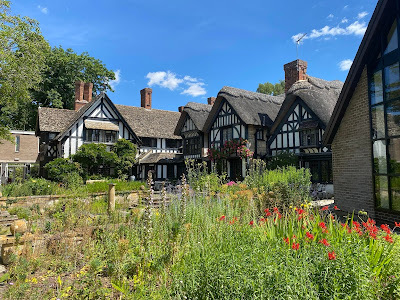
(c) Clare Helen Welsh
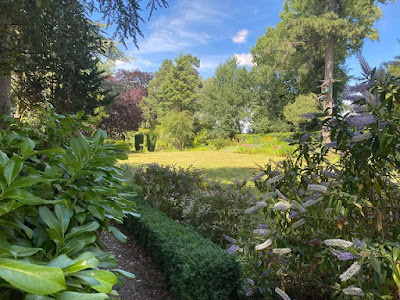 (c) Clare Helen Welsh
(c) Clare Helen Welshas someone who doesn’t picture things, I don’t get to close my eyes and relive the lovely gardens or misshapen old rooms like some people (I’ll take their word for it) do. My three big takeaways from the weekend (other people will have come away with other ones, I know) which I was keen to smuggle home so I could incorporate the retreat life into my own were:
PLAY
TUNING INTO YOU
ACCOUNTABILITY
PLAY -I was already trying to get into the play mindset before I left for the retreat and even packed my Michael Rosen Play book to get me in the mood:
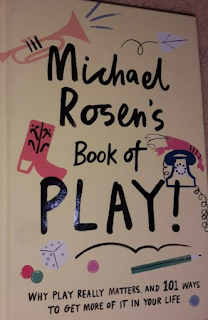
(c) Michael Rosen
And there was plenty of it there. It was particularly relevant in the Picture Book Den’s very own Pippa Goodhart’s sessions on different forms of picture book. We discussed concept books, interesting use of flaps, holes, books where the pictures are doing something quite different from the text (my favourite kind)… And we spent time playing around with ideas of our own.
I’ve always loved picture books that do things a bit differently, especially wordless books and those with few words. And I feel like I’ve been given permission (or given myself permission) to go back to a form I’ve always loved reading and writing. Pippa’s examples of different books that played with form, or where pictures play a particularly crucial role -and crucially, which publishers might be interested in them- really sparked ideas… including going back to old manuscripts of mine that I’d abandoned because they were a hard sell…
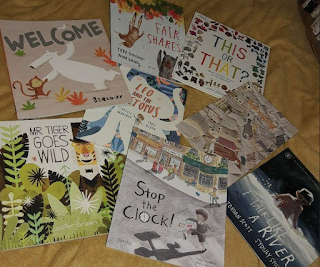
Books bought for research post retreat for potential new projects!
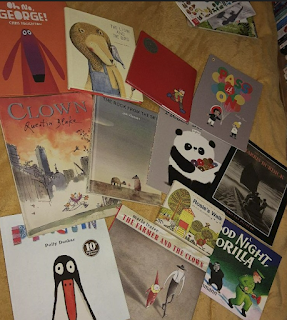
Books from home that fit with the themes/concept/style I got excited about at the retreat
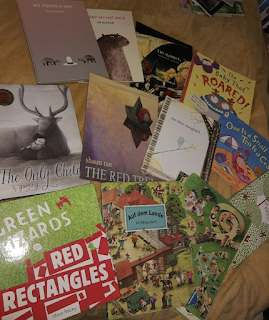 And more.... Who doesn't love a retreat that gets you excited about your own bookshelves again?
And more.... Who doesn't love a retreat that gets you excited about your own bookshelves again?
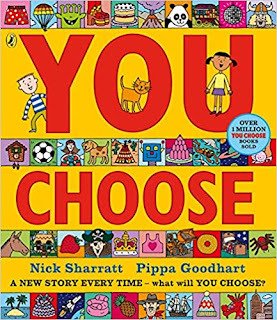
and Pippa's and Nick Sharratt's You Choose, one of my all-time favourites. I've lost two copies so far (the first, my children loved so much that one of them cut it up to use the individual pictures) and the second, I've used in schools so much with reluctant readers that I've mislaid it and need to get a third copy... I would encourage everyone who knows children between the ages of one and seven (though my children used it way beyond seven) to have a copy of this book...
TUNING INTO YOU
I’m not great with yoga. I find it really hard to do the breathing at the same time as moving, and I find following any kinds of instructions pretty difficult so it’s usually a frustrating experience for me. But we had our resident yoga instructor, and fellow author (and illustrator), Gary Fabbri, there and for those of us who wanted to (and I did want to give it a go) we started our days with yoga before breakfast.
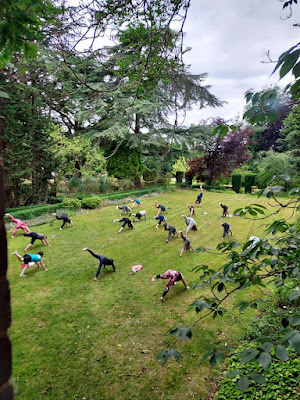
(c) Imogen Foxwell
Whilst I struggled doing the actual movements and breathing the first day, I loved that we were doing something outside and communal, but quiet, to start our day. The second day, Gary went for a simpler session, particularly useful for writers and illustrators who sit for long periods of time. And I loved it! In the evening, we did a yoga meditation (yoga nidra) where we set an intention, a question we’d like to ask ourselves relating to our writing/creating or our lives. Whilst I couldn’t do the imagery side of the meditation, I entered into the spirit of it, got hugely relaxed with the gongs, and allowed my unconscious mind to do what it wanted. The outcome? A semi-interesting answer to my own question to myself (about my current work in progress) but something else, too. It brought to mind a manuscript I’d written paying homage to another book many years ago but that couldn’t be published at the time (for copyright reasons), so I’d changed it and changed it until it was hardly recognisable. But now, seven years later, I suddenly remembered that I’m free to go back to my original one! And I’d completely forgotten its original form until that session!
Keen to build on the ‘trusting your own mind and body’ and allowing your mind some time and space to flourish, and bearing in mind that I had really enjoyed the early morning yoga, I decided to start doing something I’d not done for years when I got home: waking up at six o’clock to write. It’s absolutely the best time of the day for me to write (but I’d somehow managed to ignore that) and I enjoy it way more than I enjoy writing at other times of the day (I ignored that, too). It turns out that my inner critic prefers a lie-in and just doesn’t show up at that time of day. I don’t get out of bed, I’m often not 100 percent awake, I sometimes don’t even put on my glasses so it’s not even in focus, and I’m just happy to be creative and let it flow.
The final take home was about ACCOUNTABILITY. I already have an accountability partner with whom I meet once a week on skype -and this year she was at the retreat, too. When it came to writing our postcards to ourselves for six months’ time at the end (we all write down on a self-addressed postcard what we hope we’ll have done on the writing/illustrating front in six months’ time and then the organisers -which included Picture Book Den’s Clare Helen Welsh!- collect them in and send them to us in six months), we addressed them to each other rather than ourselves so that the other person will hold us accountable to what we’ve said we’ll do by that time. But the accountability didn’t stop there. On the way to the station, I was chatting with a few retreatees and we were talking about experimenting, playing and being less precious about our work and how we should just get more written, quickly. And we decided that we’d each commit to writing (and in some cases, illustrating) two really rough stories per month with a monthly deadline and online meeting the next day. They would have to be new stories each month (no editing and resubmitting the same one) and we wouldn’t critique them but we’d all have a quick read before we met and say one nice thing about them -but no critiquing). The idea is that if we get less precious about our writing/illustrating and our ideas then we’ll free ourselves up and write/sketch quicker and that at least some of our new ideas will be ok. We’re not thinking we’re going to create 24 good stories in a year -but there might well be some good ones in there that may never have happened were it not for this new process.
And keen to merge this new (or re-remembered) trust with play, I’ve been committing my morning writing slot to new story ideas whenever I have them so that I am being playful every day first thing in the morning. If I actively want to work on my current (serious) work in progress at 6am, then that’s fine but priority goes to being playful with new ideas. What it means is that I’m no longer feeling like I have to finish X before I can even think about any other projects, which takes away some of the positivity about the current work in progress. Now I’ve created what feels like magic free time (six till seven), I can do whatever creative projects I feel like in that time and I’m feeling more enthusiastic about all my projects because I’m feeling creatively fulfilled by playing every morning!
I even did some (relatively) early morning outside writing on holiday in Orkney just recently, including sitting on my mum’s grave

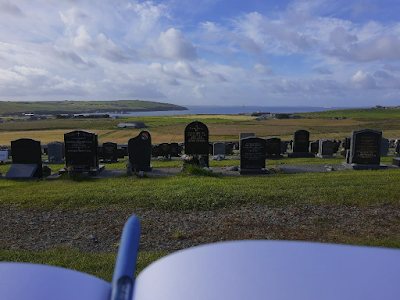
overlooking Scapa beach
and at the beach
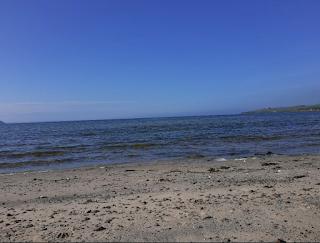
where I came up with an idea which will be one of my 'two a month' rough stories I'll try out
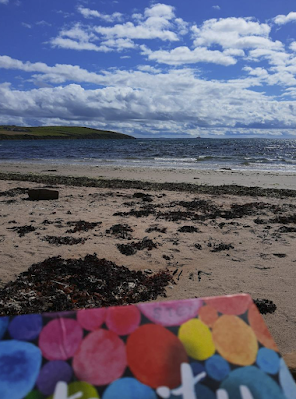
at Scapa
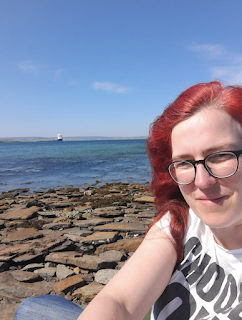
at Weyland Bay at the end of my mum and dad's old road
After getting a little nervous last week that I was losing my taste for the early mornings before discovering I actually had covid and my body just needed a lot of rest, I’m excited to start back again in a couple of days’ time. Although I’m better with quiet than I was before the retreat (which means I’m having more interesting thoughts and ideas, too), I still play birdsong as I write, but that all feeds back into recreating the retreat early morning soundscape anyway.
It's a retreat I'll remember for a long time (thank you, Paul Morton, co-organiser, too and it was great to meet fellow 'Denner, Garry Parsons at last). I know everyone will have come away with different 'take homes' but here's to listening to ourselves, being accountable and having fun!
If you have any tips or stories about being more creative, getting more done or trusting yourself in your creative practice, please do share them below in the comments section. Thank you!
Clare is a children’s author of more than 35 books and is now on a mission to have a playful year of writing…
July 31, 2022
Spark Magic with the Creative Habit • By Natascha Biebow
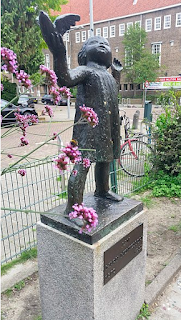
Do you think of yourself as a creative person? Maybe you think you were a bit more creative when you were a child . . . why?
Is creativity innate?
Professor George Land devised a creativity test for NASA to help select innovative engineers and scientists. In a 1968 longitudinal study, he decided to test it on other people. He found that 5 year olds scored 98% on the creativity test, while 15 year olds scored 12%, and adults just 2%.
Land concluded that “non-creative behavior is learned.”(Source: George Land and Beth Jarman, Breaking Point and Beyond.San Francisco: HarperBusiness, 1993)
So, what happens as we get older?
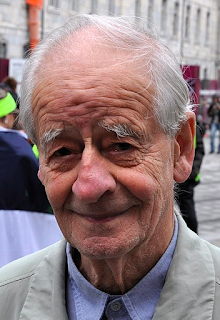 Jean Piaget (1896–1980) Swiss psychologist known
Jean Piaget (1896–1980) Swiss psychologist known
for his work on child development
From the age of 12 and up, children enter what psychologist Jean Piaget termed the Formal Operational Stage of development. They become logical thinkers, able to make more rational decisions and understand abstract ideas. Young adults can see multiple solutions to problems and consider the world through a more scientific lens.
The problem with this kind of thinking for creative outcomes is it also leads to self-criticism – mistakes and less than perfect creations are often rejected.
 Teens and Adults are often more self-critical and ask fewer questions about the world.
Teens and Adults are often more self-critical and ask fewer questions about the world. Creativity has been shown to decrease as people get older.
Adolescents also develop a leaning towards value judgment and adapting to social constraints – teens and adults are keen to stick with what they know works. Thus they favour more predictable ways of doing things, which might be more consistently successful, but are often less creative.
The traditional education system, designed during the Industrial Revolution over 200 years ago in order to turn out good workers who followed directions, reinforces this kind of thinking also.
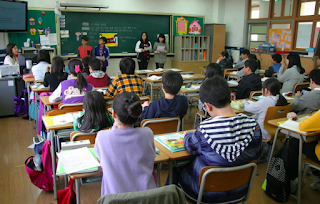 The traditional school classroom values gaining knowledge
The traditional school classroom values gaining knowledge
and following rules rather than creativity.
Ironically, however, creativity in all age groups is more important than ever now.
According to American psychologist Robert J. Sternberg, dean of the school of arts and sciences at Tufts University, “The world is changing at a far greater pace than it ever has before, and people need constantly to cope with new and unusual kinds of tasks and situations. Learning in this era must be life-long, and people constantly need to be thinking in new ways. The problems we confront, whether in our families, communities, or nations, are novel and difficult, and we need to think creativelyand divergently to solve these problems. The technologies, social customs, and tools available to us in our lives are replaced almost as quickly as they are introduced. We need to think creatively to thrive, and, at times, even to survive.”
And we need people like children’s book writers and illustrators to be creative with stories that will inspire, support and uplift young readers.
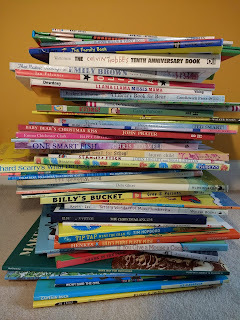 Books are key to firing up young readers' imaginations,
Books are key to firing up young readers' imaginations, developing empathy, and fostering language and (visual) literacy.
But people who are in creative professions, such as us, might also be driven by constraints such as the need to make a living.
Perhaps we feel we must make things that we know the market needs or that we think people will want to buy, as opposed to what we might make if we were given the freedom to just create from a more child-like place of ‘making something we love’.
However, any editor or agent when asked what they would like to take on for publication will inevitably recommend that people ‘write what they know’. This is because the true spark of creativity will shine through.
It creates MAGIC with readers . . .
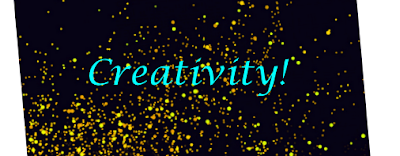
. . . because it has been created from a place of passion and freedom; it is authentic. It connects with readers intimately. Sometimes, it also the most commercial also!
Arguably, if your raison d’etre is being an author or illustrator for a living, it can be useful to develop personal systems to stay creative, even as we age:
- MAKE CREATIVITY A HABIT:
Sternberg also advises: “Creative people routinely approach problems in novel ways. Creative people habitually:
· look for ways to see problems that other people don’t look for
· take risks that other people are afraid to take
· have the courage to defy the crowd and to stand up for their own beliefs
· believe in their own ability to be creative
· seek to overcome obstacles and challenges to their views that other people give in to
· and are willing to work hard to achieve creative solutions.”
In other words, creativity is a habit that we should practise. And, as with everything, practise leads to perfection.
- KALEIDESCOPE THINKING:
 Finding random patterns and making connections often
Finding random patterns and making connections often sparks creative ideas, like the pieces in a kaleidescope.
Rosabeth Moss Kanter, Ernest L. Arbuckle Professor of Business Administration at Harvard Business School, suggests that:
“Creativity is a lot like looking at the world through a kaleidoscope. You look at a set of elements, the same ones everyone else sees, but then reassemble those floating bits and pieces into an enticing new possibility.”
According to Kanter, powered by your imagination, Kaleidoscope thinking can be encouraged by:
· Regularly making trips to new places to cultivate new and different experiences, out of the normal routine
· Engaging with critics and challengers – those who old a different world view, beliefs or make different assumptions
· Looking at what’s new and changing
· Reading widely
· Going to conferences or learning things that are new and unfamiliar
· Exchanging ideas with others
- BE CREATIVE IN OTHER AREAS (Other than Children’s Writing & Illustrating):
If you do things that are creative and also unrelated to your writing and illustration and these might spark something. For instance:
- Invent something to solve someone else’s problem
- Sew something
- Make a puppet
- Fingerpaint – make a mess!
- Create a new recipe
- Make a collage
- Make a video diary of your pet, favourite object or family member
- doodle
- Build with Lego
- Melt some crayons with a hairdryer
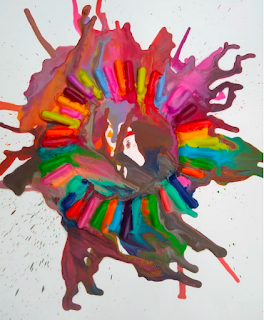 Melt some old crayons with a hairdryer and see what you can create!
Melt some old crayons with a hairdryer and see what you can create!- Change up your daily routine – eat dessert first! Go a different route round the supermarket
- LET YOUR MIND WANDER and DAYDREAM:
When you MOVE: when you go for a walk, shower, do some gardening or similar, you free up your mind. Studiesshow that this leads to creative problem solving,
- PLAY:
When we allow for creative play like children, it creates opportunities for trying out new ideas, new ways of thinking and problem solving. We can allow ourselves to discover freely, without the censure of the voice that demands validation, financial compensation or approval.
We are just playing and saying ‘hey, look what I made!’ – for FUN.
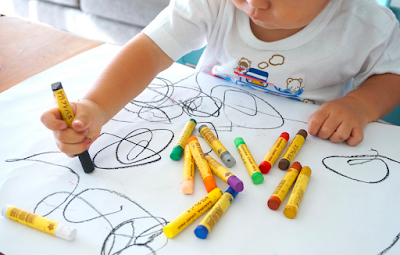 Young children are not concerned about the end product and enjoy 'making' for fun.
Young children are not concerned about the end product and enjoy 'making' for fun.
It's the process that is creative and fun.
Importantly, we have to give ourselves permission to be creative:
Visionary educator Maria Montessori said, “Imagination does not become great until human beings, given the courage and the strength, use it to create.”
Play is an important part of rearranging the kaleidescope bits to see new possibilities.
Allow and accept MISTAKES!
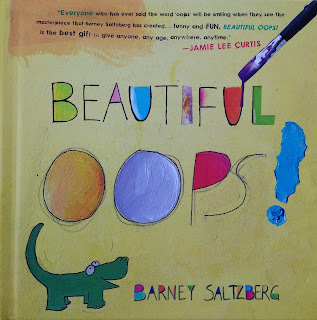 In Beautiful Oops!, Barney Saltzberg explores the
In Beautiful Oops!, Barney Saltzberg explores the
amazing creative outcomes that can come as a result of a 'mistake'.
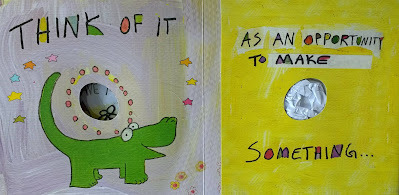
 From Beautiful Oops! by Barney Saltzberg
From Beautiful Oops! by Barney Saltzberg
- WORK WITH CONSTRAINTS:
Did you know that a bestselling Green Eggs and Ham was written as the result of a bet? When Random House founder Bennett Cerf bet one of his authors, Theo Geisel, that he couldn’t write an entertaining children’s book with just 50 different words, Dr. Seuss won that wager with Green Eggs and Ham, which has sold over 200 million copies.
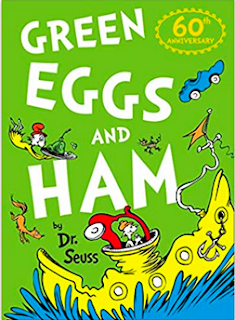 Bestselling title Green Eggs and Ham by Dr. Seuss
Bestselling title Green Eggs and Ham by Dr. Seusswas the result of a bet.
These limits stretch our problem-solving abilities and typically produce surprising results. That’s because your mind is forced into doing more divergent thinking.

Albert Einstein said:
"Creativity is seeing what others see and thinking what no one else ever thought."
So, we have to TRUST that we can innovate – having this TRUST expands creativity.
Creativity, after all, BEGETS creativity!
@font-face {font-family:"Courier New"; panose-1:2 7 3 9 2 2 5 2 4 4; mso-font-charset:0; mso-generic-font-family:auto; mso-font-pitch:variable; mso-font-signature:-536859905 -1073711037 9 0 511 0;}@font-face {font-family:Wingdings; panose-1:2 0 5 0 0 0 0 0 0 0; mso-font-charset:2; mso-generic-font-family:auto; mso-font-pitch:variable; mso-font-signature:0 268435456 0 0 -2147483648 0;}@font-face {font-family:"MS 明朝"; panose-1:0 0 0 0 0 0 0 0 0 0; mso-font-charset:128; mso-generic-font-family:roman; mso-font-format:other; mso-font-pitch:fixed; mso-font-signature:1 134676480 16 0 131072 0;}@font-face {font-family:"MS 明朝"; panose-1:0 0 0 0 0 0 0 0 0 0; mso-font-charset:128; mso-generic-font-family:roman; mso-font-format:other; mso-font-pitch:fixed; mso-font-signature:1 134676480 16 0 131072 0;}@font-face {font-family:Calibri; panose-1:2 15 5 2 2 2 4 3 2 4; mso-font-charset:0; mso-generic-font-family:auto; mso-font-pitch:variable; mso-font-signature:-520092929 1073786111 9 0 415 0;}@font-face {font-family:"Trebuchet MS"; panose-1:2 11 6 3 2 2 2 2 2 4; mso-font-charset:0; mso-generic-font-family:auto; mso-font-pitch:variable; mso-font-signature:647 0 0 0 159 0;}p.MsoNormal, li.MsoNormal, div.MsoNormal {mso-style-unhide:no; mso-style-qformat:yes; mso-style-parent:""; margin:0cm; margin-bottom:.0001pt; mso-pagination:widow-orphan; font-size:12.0pt; font-family:"Times New Roman"; mso-fareast-font-family:"MS 明朝"; mso-fareast-theme-font:minor-fareast; mso-ansi-language:EN-US;}h1 {mso-style-priority:9; mso-style-unhide:no; mso-style-qformat:yes; mso-style-link:"Heading 1 Char"; mso-margin-top-alt:auto; margin-right:0cm; mso-margin-bottom-alt:auto; margin-left:0cm; mso-pagination:widow-orphan; mso-outline-level:1; font-size:24.0pt; font-family:"Times New Roman";}a:link, span.MsoHyperlink {mso-style-priority:99; color:blue; mso-themecolor:hyperlink; text-decoration:underline; text-underline:single;}a:visited, span.MsoHyperlinkFollowed {mso-style-noshow:yes; mso-style-priority:99; color:purple; mso-themecolor:followedhyperlink; text-decoration:underline; text-underline:single;}p.MsoListParagraph, li.MsoListParagraph, div.MsoListParagraph {mso-style-priority:34; mso-style-unhide:no; mso-style-qformat:yes; margin-top:0cm; margin-right:0cm; margin-bottom:0cm; margin-left:36.0pt; margin-bottom:.0001pt; mso-add-space:auto; mso-pagination:widow-orphan; font-size:12.0pt; font-family:"Times New Roman"; mso-fareast-font-family:"MS 明朝"; mso-fareast-theme-font:minor-fareast; mso-ansi-language:EN-US;}p.MsoListParagraphCxSpFirst, li.MsoListParagraphCxSpFirst, div.MsoListParagraphCxSpFirst {mso-style-priority:34; mso-style-unhide:no; mso-style-qformat:yes; mso-style-type:export-only; margin-top:0cm; margin-right:0cm; margin-bottom:0cm; margin-left:36.0pt; margin-bottom:.0001pt; mso-add-space:auto; mso-pagination:widow-orphan; font-size:12.0pt; font-family:"Times New Roman"; mso-fareast-font-family:"MS 明朝"; mso-fareast-theme-font:minor-fareast; mso-ansi-language:EN-US;}p.MsoListParagraphCxSpMiddle, li.MsoListParagraphCxSpMiddle, div.MsoListParagraphCxSpMiddle {mso-style-priority:34; mso-style-unhide:no; mso-style-qformat:yes; mso-style-type:export-only; margin-top:0cm; margin-right:0cm; margin-bottom:0cm; margin-left:36.0pt; margin-bottom:.0001pt; mso-add-space:auto; mso-pagination:widow-orphan; font-size:12.0pt; font-family:"Times New Roman"; mso-fareast-font-family:"MS 明朝"; mso-fareast-theme-font:minor-fareast; mso-ansi-language:EN-US;}p.MsoListParagraphCxSpLast, li.MsoListParagraphCxSpLast, div.MsoListParagraphCxSpLast {mso-style-priority:34; mso-style-unhide:no; mso-style-qformat:yes; mso-style-type:export-only; margin-top:0cm; margin-right:0cm; margin-bottom:0cm; margin-left:36.0pt; margin-bottom:.0001pt; mso-add-space:auto; mso-pagination:widow-orphan; font-size:12.0pt; font-family:"Times New Roman"; mso-fareast-font-family:"MS 明朝"; mso-fareast-theme-font:minor-fareast; mso-ansi-language:EN-US;}span.Heading1Char {mso-style-name:"Heading 1 Char"; mso-style-priority:9; mso-style-unhide:no; mso-style-locked:yes; mso-style-link:"Heading 1"; mso-ansi-font-size:24.0pt; mso-bidi-font-size:24.0pt; mso-font-kerning:18.0pt; mso-fareast-language:EN-US; font-weight:bold;}span.hgkelc {mso-style-name:hgkelc; mso-style-unhide:no;}span.quotesign {mso-style-name:quote_sign; mso-style-unhide:no;}.MsoChpDefault {mso-style-type:export-only; mso-default-props:yes; font-size:10.0pt; mso-ansi-font-size:10.0pt; mso-bidi-font-size:10.0pt; mso-fareast-font-family:"MS 明朝"; mso-fareast-theme-font:minor-fareast; mso-fareast-language:JA;}div.WordSection1 {page:WordSection1;}ol {margin-bottom:0cm;}ul {margin-bottom:0cm;}
Sculpture image of girl "Meisje met vogel, gedenkteken voor Maria Montessori" in Amsterdam by artist Gerarda Rueter
_________________________________________________________________
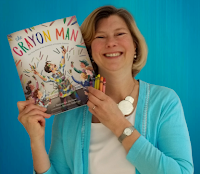 Natascha Biebow, MBE, Author, Editor and Mentor
Natascha Biebow, MBE, Author, Editor and Mentor Natascha is the author of the award-winning The Crayon Man: The True Story of the Invention of Crayola Crayons, illustrated by Steven Salerno, winner of the Irma Black Award for Excellence in Children's Books, and selected as a best STEM Book 2020. Editor of numerous prize-winning books, she runs Blue Elephant Storyshaping, an editing, coaching and mentoring service aimed at empowering writers and illustrators to fine-tune their work pre-submission, and is the Editorial Director for Five Quills. Find out about her new picture book webinar courses! She is Co-Regional Advisor (Co-Chair) of SCBWI British Isles. Find her at www.nataschabiebow.com
July 24, 2022
An Interview with John Condon - Lynne Garner
Me: Inspiration - how and when does inspiration strike you?
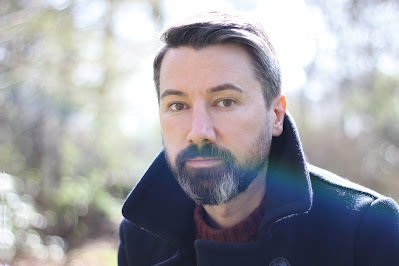 John: Gosh! Inspiration can, and has, struck at any and every moment you can imagine. I’ve come up with ideas watching TV, reading news articles, scrolling through various social media feeds, listening to music, and whilst having conversations. I’ve also come up with ideas whilst drifting off to sleep, waking up from sleep, and even DURING sleep. I’ve gotten quite good at spotting an idea, so even whilst sleeping, my unconscious mind will switch on once an idea reveals itself and I’ll wake up!
John: Gosh! Inspiration can, and has, struck at any and every moment you can imagine. I’ve come up with ideas watching TV, reading news articles, scrolling through various social media feeds, listening to music, and whilst having conversations. I’ve also come up with ideas whilst drifting off to sleep, waking up from sleep, and even DURING sleep. I’ve gotten quite good at spotting an idea, so even whilst sleeping, my unconscious mind will switch on once an idea reveals itself and I’ll wake up!So, my top tip for all new writers is to keep a notebook and pencil, or a (charged) phone on their person, or close to hand, at ALL times. So you never lose that initial idea.
Me: How do you know when an idea will make a good picture book?
John: It’s tricky to know which ideas will make the best picture books, but it’s usually the simplest and clearest ones. I often generate ideas that my editors tell me should be chapter books. I’m still reluctant to write one of those, so I’ve often squished a chapter book idea into a picture book format, only for it to be rejected. Understandably!
Me: I sketch out ideas on paper. How do you plan your books?
John: I’ve developed my process over the years, and I think I’ve gotten it to a place where it works for me now. In the past I’d get an idea, rush to the end (in my head) and then straight away start writing a draft, with my only intention being to get from the A to the Z that I’d already generated. Often this approach would result in a protracted journey with a frustrating conclusion. Now, I don’t rush to first draft. Instead, I generate ideas and add to them over time. I let them gestate and ruminate and slowly build them in the form of an outline.
Once I have a page or so of information (I write in MS Word) I revaluate the idea. If it feels simple but exciting, familiar but surprising, I start to split the outline into spreads. I’ll be doing this with a few ideas at the same time. Never falling in love with any of them until one demands my attention. If all my eggs aren’t in one basket, I’ll be less inclined to make the mistake of wanting it to work and committing to it too early. If the outline breaks down across spreads seamlessly, the imagery invades my daydreams and the characters start to come alive and talk to me, that’s when I pause everything else and commit to this idea.
At that point, the process becomes a collaborative one. I ask my wonderful crit group for their thoughts, because they’re all talented storytellers, and they’ll beat it into even better shape. I’ll then carry on developing it at pace... unless they’ve told me it’s another chapter book idea.
Me: I've been asked to make a variety of changes to my picture books. What types of changes have you been asked to make?
John: For my book The Wondrous Dinosaurium, the publisher had concerns about the title and they asked me to come up with alternatives. I thought I’d nailed it with one of them (and it was used as a placeholder for a while) but we ultimately went back to the original one. Looking back, I wish we’d gone with the simpler title as people often stumble over or misremember the chosen one.
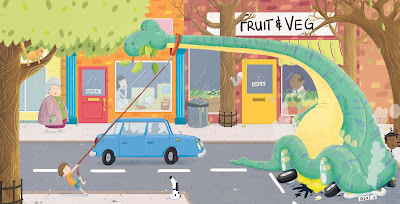 The Wonderous Dinosaurium
The Wonderous DinosauriumFor my latest book The Best Bear Tracker the publisher had the story for a year. I then received a call saying the ending wasn't working. They were very good about it and agreed for me to have a go at some alternatives. I provided them with around five or six. Thankfully they loved one of them and that’s the one you see in the published version. The previous ending was soooo different. I much prefer this one though.
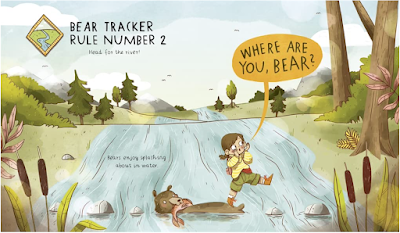 The Best Bear Tracker
The Best Bear TrackerMe: I've worked on stories for months even years. What’s the longest you’ve worked on a story?
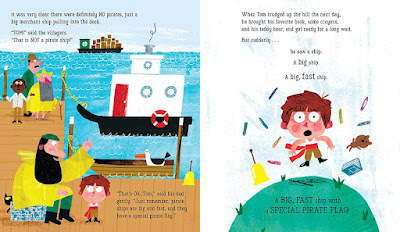 The Pirates are ComingJohn: I sold the ideas for The Pirates Are Coming, during the Christmas of 2015 but it didn't get published until Feb 2020. I had moments of self-doubt along the way, and bombarded my poor editor with lots of versions, including one or two with an astonishing amount of alliteration. Thankfully she rejected those. She is a wonderful and patient editor and really helped me hone the story.
The Pirates are ComingJohn: I sold the ideas for The Pirates Are Coming, during the Christmas of 2015 but it didn't get published until Feb 2020. I had moments of self-doubt along the way, and bombarded my poor editor with lots of versions, including one or two with an astonishing amount of alliteration. Thankfully she rejected those. She is a wonderful and patient editor and really helped me hone the story.
Me: Are you working on ideas now?

John: I’m always working on new ideas. As they say, ‘watch this space.’
Me: Thanks John for sharing your journey. And I've made note to get myself a crit group.
July 17, 2022
Merchaps, by Pippa Goodhart
Over twenty years ago, back in the last millennium, I wrote a story for the Blue Banana series of illustrated early reader books. It was about a boy called Toby who finds a mermaid stranded in a rockpool. He takes her home and tries to make her happy. But, although she enjoys playing with Toby and his sisters, the mermaid remains 'happy sad' because she also misses her home. So Toby takes her back to the sea, and they each go back to their own family and home. Happy Sad was beautifully illustrated by Stephen Lambert. I have one of the original pictures in the main room in my house.
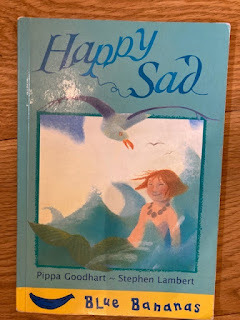
Over many school visits with young children over many years, Happy Sad proved to be one of those books that quietened children, hushing as they listened more and more intently. And, at the end of a reading, they’d be eager to discuss whether or not they would take the mermaid back to the sea, and whether she might come back to visit Toby, or Toby swim down to visit her family. And how do they feel when they go and stay at another house with different people? Are they, perhaps, 'happy sad' when doing sleepovers? Lots of talk!
There had been discussion with the publishing people querying whether or not I should change my boy, Toby, for a girl. At the time it was an oddity to have a story about a boy and a mermaid, rather than a girl. That's why I wanted to stick with it. But not once in all those years since publication has any child ever said that they thought the story should have been about a girl. And, at last, the grown-ups seem to be catching up!
Here is award-winning joyful, gorgeous Julian And The Mermaid, written and illustrated by Jessica Love, about a boy who wants to be a mermaid.
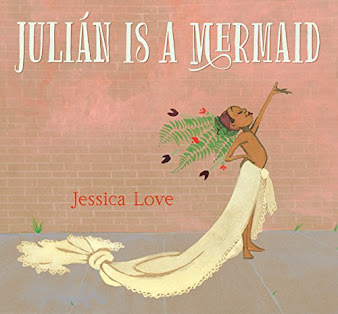
We have the mermen wittily illustrated by David Roberts for Eleanor Cullen’s A Match For A Mermaid.
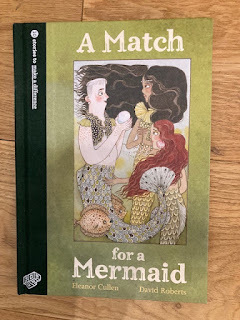
And a beautiful love story between a merman and a fisherman in Ian Eagleton and James Mayhew’s Nen And The Lonely Fisherman.
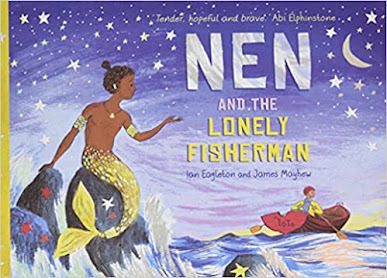
And I’m delighted to say that Happy Sad is also back in bookshops and libraries, slightly updated and given gloriously watery new illustrations by Augusta Kirkwood.
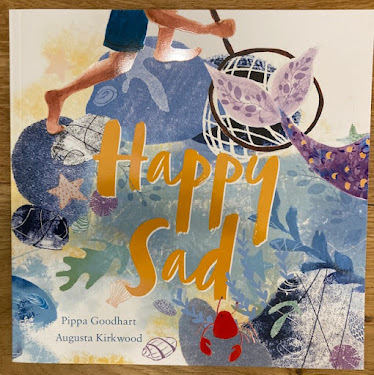
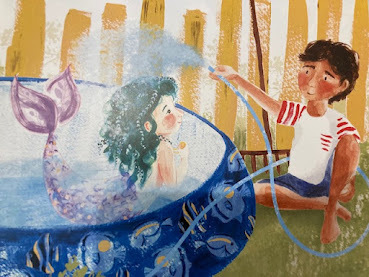
If only we could all grow a strong scaly tail, be able to breath in water, and dive deep deep into the sea to cool off just now!
July 10, 2022
A story with a gentle voice by Yijing Li
This week, we invite debut picture book author-illustrator to talk to us about how the books she read as a child have influenced her and the type of stories she wants to tell.
Over to you, Yijing
When I was growing up, I was an avid reader. Of the stories I read, some of them were happy and some sad (though most ended on a happier note). I enjoyed them all, but it was always the sad ones that stayed with me.
Now that I am writing my own children’s stories it struck me that I am consistently drawn to melancholic themes, and I wondered if this had something to do with the stories I read as a child.One of the most memorable stories I read was the Happy Prince by Oscar Wilde (below is the illustrated version from my childhood).
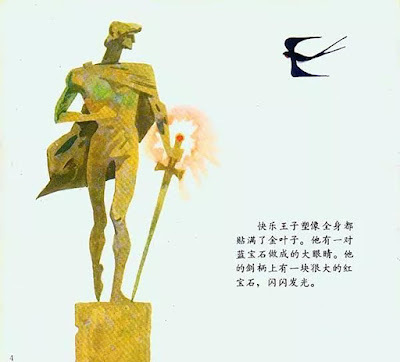
In this story the arc of the main characters - the prince and the swallow, trends ever downwards and concludes with their death.
As a child I remember feeling intensely emotional about this ending (the misleading title likely did not prepare me well for it). Having not experienced any deep feelings of sadness up to that point in my life, the swallow’s last kiss and the prince’s broken heart was my first glimpse at the inevitability of death and the separation that comes with it.
Despite the uneasiness I felt about this story, I kept coming back to it over the years. Each reading brought me new insights into the human condition. And as I grew up so too did the story, revealing to me its rich undercurrent of themes of homosexuality and wealth gap.
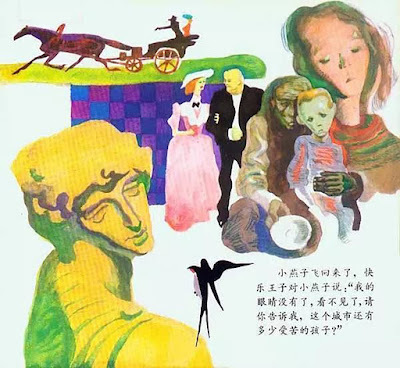
Like many classic children’s stories, I wonder if the themes of Wilde’s story might be considered too uncomfortable for children today. In fact, when I first put together the storyboard of my recently published story Through The Forest, my initial reaction was that the theme of feeling lost and alone might be too dark for a children’s book.

In Through The Forest, a boy overcomes his dejection with the help of a companion giant named Emptiness. Together they traverse a dark forest which slowly comes alive with each keepsake they find, and by remembering both the happy and sad memories the boy learns that all of his past define who he is, and will guide him in the journeys to come.
Much like the Happy Prince, Through The Forest is inherently a sad story (though it ends with a positive message), and explores topics which are not often covered in children’s books.
But should stories of this kind be left out from a child’s bookshelf? Though children may process emotions differently to adults, this should not preclude them from it. In fact, studies have shown that just like adults, children as young as the age of five can experience depression, and some would require mental health care.

In my own experience, exposures to such stories in my childhood showed me that emotions go beyond the serene and happy world my parents built for me, it gave me the strength to stand up to difficult situations later on in my life, and it taught me empathy.
When I first pitched Through The Forest, the most common feedback I received was that perhaps it was not suitable for the children’s book market. Yet I felt that it was important to tell a story of this kind to children, especially in today’s world where there are so many ways for a story to be told and so many channels through which it could be told. I wanted Through The Forest to be a complex story with a gentle voice, a story that can be a companion to its readers and allow them discover new meanings each time they returned to it.
Looking back on it now I am glad I persisted and am thankful that my publisher, Lantana Publishing, decided to partner with me on telling this story. There is a place for both the happy and the sad stories, and children need them just as much as we do.
Find out more about Yijing Li here - https://yijing-li.com/about and follow her on Instagram here: @yijing_illustration
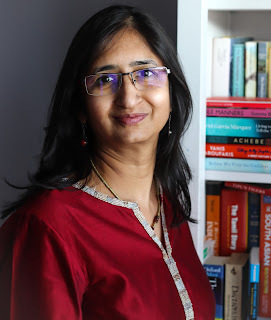
Chitra Soundar is an internationally published, award-winning author and storyteller. Her latest picture books are Holi Hai! And We All Celebrate. Find out more at http://www.chitrasoundar.com/ and follow her on twitter here and Instagram here.
A story with a gentle voice by Yijing Lee
This week, we invite debut picture book author-illustrator to talk to us about how the books she read as a child have influenced her and the type of stories she wants to tell.
Over to you, Yijing
When I was growing up, I was an avid reader. Of the stories I read, some of them were happy and some sad (though most ended on a happier note). I enjoyed them all, but it was always the sad ones that stayed with me.
Now that I am writing my own children’s stories it struck me that I am consistently drawn to melancholic themes, and I wondered if this had something to do with the stories I read as a child.One of the most memorable stories I read was the Happy Prince by Oscar Wilde (below is the illustrated version from my childhood).

In this story the arc of the main characters - the prince and the swallow, trends ever downwards and concludes with their death.
As a child I remember feeling intensely emotional about this ending (the misleading title likely did not prepare me well for it). Having not experienced any deep feelings of sadness up to that point in my life, the swallow’s last kiss and the prince’s broken heart was my first glimpse at the inevitability of death and the separation that comes with it.
Despite the uneasiness I felt about this story, I kept coming back to it over the years. Each reading brought me new insights into the human condition. And as I grew up so too did the story, revealing to me its rich undercurrent of themes of homosexuality and wealth gap.

Like many classic children’s stories, I wonder if the themes of Wilde’s story might be considered too uncomfortable for children today. In fact, when I first put together the storyboard of my recently published story Through The Forest, my initial reaction was that the theme of feeling lost and alone might be too dark for a children’s book.

In Through The Forest, a boy overcomes his dejection with the help of a companion giant named Emptiness. Together they traverse a dark forest which slowly comes alive with each keepsake they find, and by remembering both the happy and sad memories the boy learns that all of his past define who he is, and will guide him in the journeys to come.
Much like the Happy Prince, Through The Forest is inherently a sad story (though it ends with a positive message), and explores topics which are not often covered in children’s books.
But should stories of this kind be left out from a child’s bookshelf? Though children may process emotions differently to adults, this should not preclude them from it. In fact, studies have shown that just like adults, children as young as the age of five can experience depression, and some would require mental health care.

In my own experience, exposures to such stories in my childhood showed me that emotions go beyond the serene and happy world my parents built for me, it gave me the strength to stand up to difficult situations later on in my life, and it taught me empathy.
When I first pitched Through The Forest, the most common feedback I received was that perhaps it was not suitable for the children’s book market. Yet I felt that it was important to tell a story of this kind to children, especially in today’s world where there are so many ways for a story to be told and so many channels through which it could be told. I wanted Through The Forest to be a complex story with a gentle voice, a story that can be a companion to its readers and allow them discover new meanings each time they returned to it.
Looking back on it now I am glad I persisted and am thankful that my publisher, Lantana Publishing, decided to partner with me on telling this story. There is a place for both the happy and the sad stories, and children need them just as much as we do.
Find out more about Yijing Lee here - https://yijing-li.com/about and follow her on Instagram here: @yijing_illustration

Chitra Soundar is an internationally published, award-winning author and storyteller. Her latest picture books are Holi Hai! And We All Celebrate. Find out more at http://www.chitrasoundar.com/ and follow her on twitter here and Instagram here.



